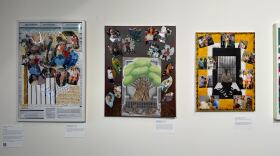An exhibition at Seattle's Museum of Pop Culture celebrates tattoos. "Body of Work" provides a historical overview of the genre, along with profiles of some of the most prominent artists based around the Pacific Northwest. And it offers practical tips for people considering getting one for the first time.
It also starts with something new for MoPOP.
The curators commissioned an indigenous colleague to help give the tattoo stories additional local context. In this small way, the show acknowledges up front that it takes place on land once surrounded by indigenous cultures.
“This is the first time MoPOP has made a land acknowledgement and we see it as important to fulfilling our mission of living our core values,” curator Amalia Kozloff said in an emailed statement.
“Globally, indigenous cultures have a deep history of body modification in all forms," the statement reads. "We believe it is important to be allies to diverse voices in museum exhibitions.”

The writings of Sasha La Pointe are the first thing most visitors will see as they enter the gallery. She's Coast Salish, from the Upper Skagit and Nooksack tribes.
Kozloff says La Pointe’s unique voice as a writer and poet provides a wider lens than just the work of a historian would.
La Pointe says she was delighted and a little surprised to be asked, because she in no way views herself as a tattoo expert. But she is heavily tattooed and very interested in the traditions of body modification in tribal culture.
“I was really excited that they asked me, simply because it showed that MoPOP cared about indigenous representation,” La Pointe said. “It shows that they cared, they wanted a Coast Salish voice to be part of this show, that is taking place on Coast Salish land.”
She says her assignment was to welcome people with that fact — and remind them.
“So, yeah, 'you’re on Coast Salish territory. Here’s our relationship to this particular art form, or what’s known about it.'”
But she says her assignment was tricky. She had to find out as much as she could about how this art form fits into what is — unlike some other tribes — not a known tattoo culture.
“And if we had been, it existed pre-contact. And through my digging and research, that’s kind of what I found,” she said.
Through interviews with several tribal elders and an anthropologist, she found one mention of Coast Salish tatoos for young women. They were made using blackberry juice as ink, to create circular patterns for protection during puberty. And she says one elder had the silhouette of local mountains tatooed on her wrist, to signal where she came from.
But more than anything, LaPointe says she found clues to a culture that has been mostly erased. And after all her research, she says what's striking is how little is still known.
She points out that tattoos are often about affirming identity. And just as she wears traditional jewelry made of dentalium shells, along with tattoos commemorating her relationships to her elders, there's a local revitalization going on of indigenous tattoo culture.
The "Body of Work" exhibition at MoPOP runs through May 25.









